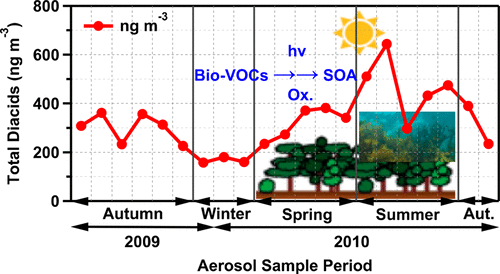当前位置:
X-MOL 学术
›
ACS Earth Space Chem.
›
论文详情
Our official English website, www.x-mol.net, welcomes your feedback! (Note: you will need to create a separate account there.)
Seasonal Distributions and Stable Carbon Isotope Ratios of Water-Soluble Diacids, Oxoacids, and α-Dicarbonyls in Aerosols from Sapporo: Influence of Biogenic Volatile Organic Compounds and Photochemical Aging
ACS Earth and Space Chemistry ( IF 3.4 ) Pub Date : 2018-10-16 00:00:00 , DOI: 10.1021/acsearthspacechem.8b00105 Chandra Mouli Pavuluri 1, 2 , Kimitaka Kawamura 1, 3 , Pingqing Fu 2
ACS Earth and Space Chemistry ( IF 3.4 ) Pub Date : 2018-10-16 00:00:00 , DOI: 10.1021/acsearthspacechem.8b00105 Chandra Mouli Pavuluri 1, 2 , Kimitaka Kawamura 1, 3 , Pingqing Fu 2
Affiliation

|
To better understand the origins and photochemical processing of organic aerosols over Northeast Asia, we studied diacids, oxoacids, and α-dicarbonyls and their stable carbon isotope ratios (δ13C) in atmospheric aerosols collected at Sapporo, Japan. Molecular distributions of diacids and related compounds were characterized by a predominance of oxalic acid (C2) followed by malonic (C3), glyoxylic (ωC2), and succinic (C4) acids. Saturated normal diacids (C2–C11, excluding C6) and long-chain oxoacids (ωC7–ωC9) showed a seasonal pattern; gradually decreased from autumn to winter and then increased through spring with a peak in early summer. Short-chain oxoacids and α-dicarbonyls and δ13C of all species including diacids did not show a seasonal pattern. 13C was enriched in saturated normal diacids with a decrease in carbon numbers. Short-chain oxoacids and glyoxal were more enriched with 13C than C2 diacid. Our results together with organic tracers demonstrate that seasonal distributions are driven by enhanced biogenic emissions and photochemical processing in spring/summer. In contrast, the contributions from biomass burning and fossil fuel combustion were higher in autumn and winter. This study provides the insights to modify the atmospheric chemical transport models by the inclusion of season specific biogenic emissions.
中文翻译:

札幌气溶胶中水溶性二酸,含氧酸和α-二羰基化合物的季节性分布和稳定碳同位素比:生物挥发性有机化合物和光化学老化的影响
为了更好地理解的起源和超过东北亚有机气溶胶光化学处理,我们研究了二元酸,含氧酸,α二羰基和它们的稳定的碳同位素比率(δ 13在日本札幌收集大气气溶胶C)。通过草酸(C占优势二酸和相关化合物的分子分布,其特征在于2接着丙二酸(C)3),二羟(ωC 2)和琥珀酸(C 4)的酸。饱和正常二酸(C 2 -C 11,除C以外6)和长链含氧酸(ωC 7 -ωC 9)表现出季节性模式;从秋季到冬季逐渐减少,然后在春季增加,初夏达到峰值。短链含氧酸和α二羰基和δ 13所有物种,包括二酸没有表现出一个季节性图案℃。13 C富含饱和的正常二酸,碳原子数减少。短链含氧酸和乙二醛比C 2富含13 C二酸。我们的结果与有机示踪剂一起表明,春季/夏季生物源排放量的增加和光化学处理的增加驱动了季节分布。相反,秋季和冬季,生物质燃烧和化石燃料燃烧的贡献较高。这项研究通过包含特定季节的生物成因排放物,提供了修改大气化学迁移模型的见识。
更新日期:2018-10-16
中文翻译:

札幌气溶胶中水溶性二酸,含氧酸和α-二羰基化合物的季节性分布和稳定碳同位素比:生物挥发性有机化合物和光化学老化的影响
为了更好地理解的起源和超过东北亚有机气溶胶光化学处理,我们研究了二元酸,含氧酸,α二羰基和它们的稳定的碳同位素比率(δ 13在日本札幌收集大气气溶胶C)。通过草酸(C占优势二酸和相关化合物的分子分布,其特征在于2接着丙二酸(C)3),二羟(ωC 2)和琥珀酸(C 4)的酸。饱和正常二酸(C 2 -C 11,除C以外6)和长链含氧酸(ωC 7 -ωC 9)表现出季节性模式;从秋季到冬季逐渐减少,然后在春季增加,初夏达到峰值。短链含氧酸和α二羰基和δ 13所有物种,包括二酸没有表现出一个季节性图案℃。13 C富含饱和的正常二酸,碳原子数减少。短链含氧酸和乙二醛比C 2富含13 C二酸。我们的结果与有机示踪剂一起表明,春季/夏季生物源排放量的增加和光化学处理的增加驱动了季节分布。相反,秋季和冬季,生物质燃烧和化石燃料燃烧的贡献较高。这项研究通过包含特定季节的生物成因排放物,提供了修改大气化学迁移模型的见识。


























 京公网安备 11010802027423号
京公网安备 11010802027423号